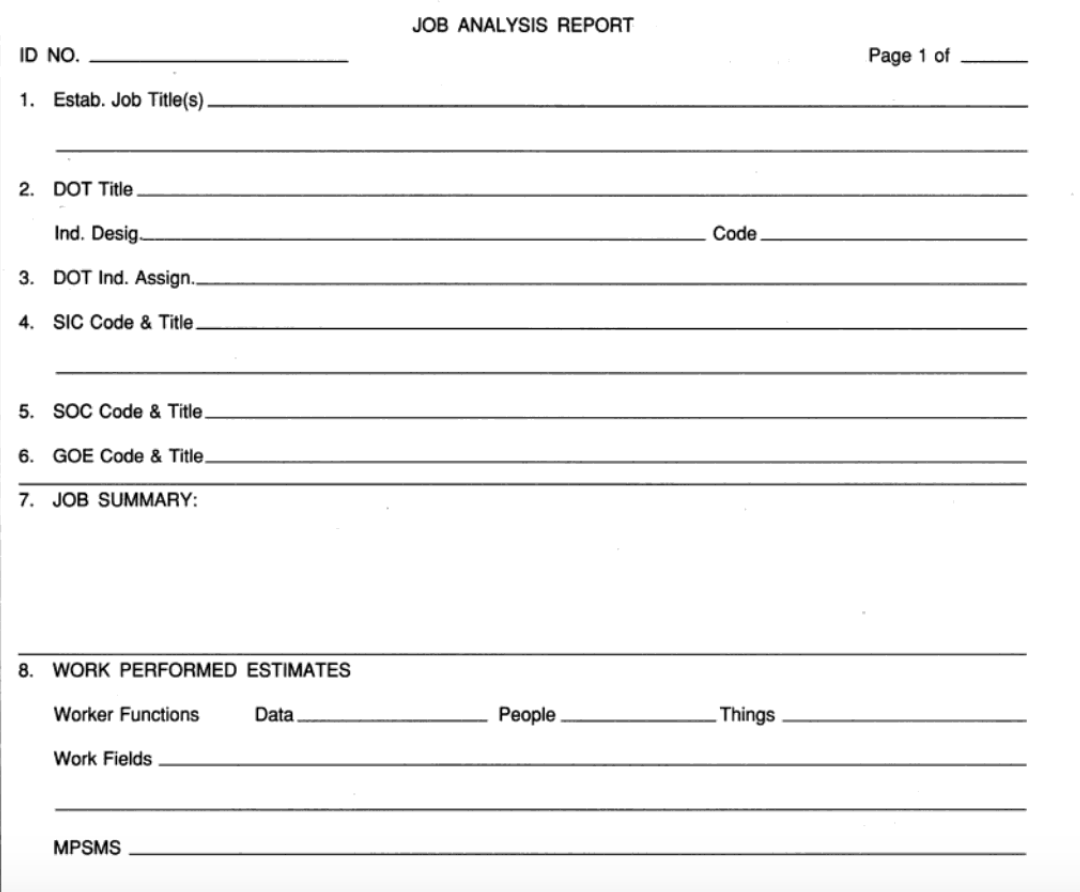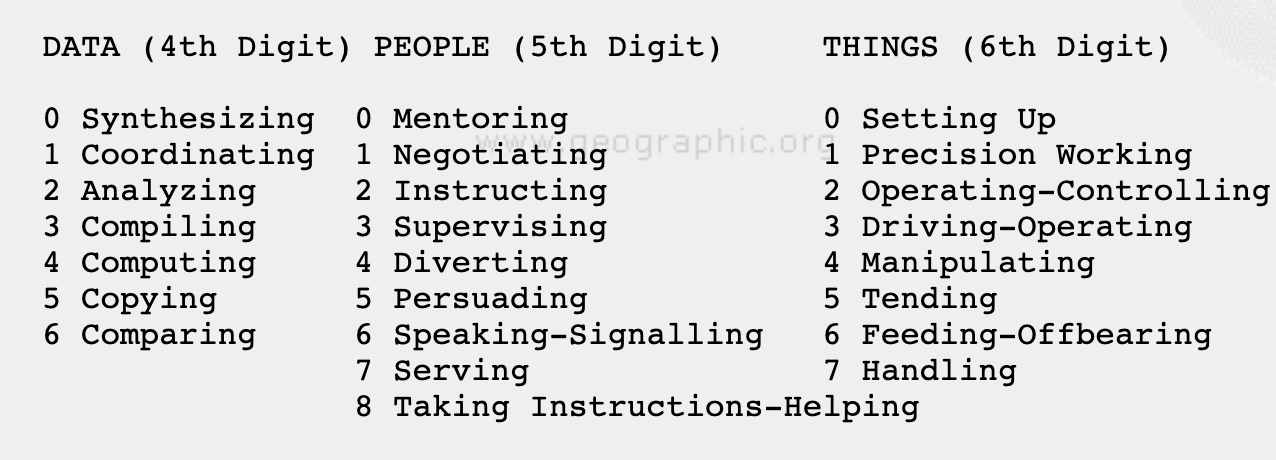
The same way that every English word is in the Oxford Dictionary, the DOT worked to define, categorize, and sort every job, publishing four editions between 1939 and 1991. In its first edition, this ambitious project cataloged over 17,500 occupations within 550 occupational groups.
But how do you take all of the complexities of a job, and distill it into a 9 digit number? This project by the Labor Department can help shed some light on the value system used to categorize work. Although it is no longer in circulation today, the issues with the DOT persist in many of our existing work classification systems.
How the DOT Categorized Work
The DOT relied on field interviews and job observations by the Occupational Analysts, a government role described in their own words (per the DOT definition) as a position that, “Researches occupations and analyzes and integrates data to develop and devise concepts of worker relationships, modify and maintain occupational classification system, and provide business, industry, and government with technical occupational information necessary for utilization of workforce: Confers with business, industry, government, and union officials to arrange for and develop plans for studies and surveys.”
The OAs relied on standardized instructions from the Department of Labor’s Handbook for Analyzing Jobs, consolidating their research into forms such as the one pictured below.

Using the data they collected in the field, they used a coding scheme to create a unique 9 digit code for every occupation. The first digit of an occupational code placed it into one of the 9 primary Occupational Categories:
- Professional, Technical, and Managerial Occupations
- Clerical and Sales Occupations
- Service Occupations
- Agricultural, Fishery, Forestry, and Related Occupations
- Processing Occupations
- Machine Trades Occupations
- Benchwork Occupations
- Structural Work Occupations
- Miscellaneous Occupations
The next digits place the occupation into a more specific Division within that occupation, followed by a Worker Functions rating, based on psychologist Sidney Fine’s 1955 work on functional job analysis. This categorized the occupation according to its relationship with Data, People, and Things, with higher scores indicating higher levels of responsibility or judgment.

The OAs would repeat this process at several firms of various sizes, and compile the data into a final code and definition. The last digits are just to ensure the code is unique, leading a classification such as Goat Herder, pictured below.

This data was used as a placement and counseling tool for the U.S. Employment Services offices, linking the jobs in demand with the labor supply. The DOT was also consulted by educational institutions, private companies, and other government offices, including the Bureau of Labor Statistics and the Social Security Administration.
The Consequences of Defining Work
The Problems with the DOT
The DOT received criticism throughout the latter half of the 20th century, for several reasons. First, the publications could not keep up with the pace of change in the labor market, creating problems with reliability— emphasizing blue-collar jobs in an economic landscape shifting towards service and knowledge professions. Another underlying challenge with the DOT system was its limited comparability with other population survey data, including the occupational categories listed in the U.S. census.
It was also criticized for potential bias in its classification system. A 1980 analysis from the National Research Council remarked on sex-bias, noting that, “Typist, a job held mainly by women, was coded as having no significant relationship to things, whereas Typesetting Machine Tender, a job held mainly by men, was coded at a higher level of complexity.”
Despite being officially retired in 1998, replaced with an online database called the Occupational Information Network (O*NET), the main problem with the DOT is its continued use as a resource as late as 2020 in several capacities:
- Used to evaluate individuals who are applying for Social Security disability benefits, although the source, “does not address certain taxing aspects of most forms of work, such as mental and emotional strain.”
- Used as a source of data in academic research, to study job tasks in labor economics and training requirements for studies in human resources. As a consequence, its potentially flawed methods of data collection and categorization are perpetuated into modern-day workforce analysis.
Job Levels used by the Bureau of Labor Statistics
In our attempts to define work, there tend to be unforeseen consequences. Today, we can see potential problems with the BLS National Compensations Survey, which evaluates occupations along 4 factors — knowledge, job controls and complexity, contacts (nature and purpose), and physical environment — and assigns those occupations to one of 15 levels.
In their guide for determining the occupational level, the potential point values vary significantly between the major occupational groups. For example, to evaluate knowledge level, points are designated to service occupations at a starting value of 50 points to a maximum of 1250 points, where communications and arts jobs have a starting value of 550 points, with a maximum of 1850 points.
Representing work as it really is might just be an impossible task. Every attempt to classify or label work — whether by the average education level, tasks, or skills required — will rely on assumptions and impose biases that can affect how that work is valued. As we see today over the discussions on what it means to be an “essential” worker, or who should be classified as an “employee,” these labels often do more than describe things as they are, but rather prescribe a status in society.



